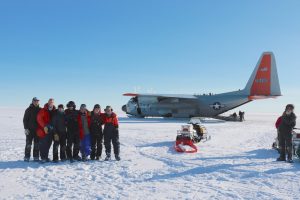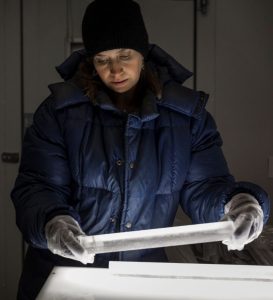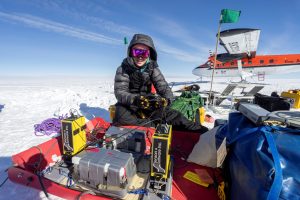 Ice cores from the polar regions provide the most direct information possible about the climate in the past, an important part of understanding how climate will change in the future. The University of Washington glaciology group has played a leading role in ice core research for decades, and that legacy continues with two major decade-length projects funded by the National Science Foundation.
Ice cores from the polar regions provide the most direct information possible about the climate in the past, an important part of understanding how climate will change in the future. The University of Washington glaciology group has played a leading role in ice core research for decades, and that legacy continues with two major decade-length projects funded by the National Science Foundation.
The Hercules Dome project, led by ESS Professors Eric Steig, TJ Fudge, and Knut Christianson, aims to obtain ice from the last interglacial period, about 130,000 years ago, when the West Antarctic ice sheet (WAIS) may have collapsed. Knowing whether, and how quickly, the WAIS collapsed is critical for understanding the risk of similar collapse in the future. A complete loss of the WAIS would raise sea level by about 3 meters. Hercules Dome is uniquely sensitive to the size of the WAIS, because it lies in the mountains immediately adjacent to it. Fieldwork over the last few years has selected the best location to drill an ice core.
The COLDEX (Center for Oldest Ice Exploration) project is an NSF “Science and Technology Center”, led by faculty at Oregon State University, with UW as a major partner. Professor Michelle Koutnik is the lead at UW, and the project also involves Steig, Christianson, Fudge, Prof. Dale Winebrenner, and others. The COLDEX Science and Technology center brings together an ambitious research program with coordinated education, outreach and knowledge transfer programs. The aim of the COLDEX project is to find and analyze the oldest ice on Earth; the project has already discovered and begun to analyze ice more than 4 millions years old. The goal now is to obtain, if possible, a continuous record extending through that entire time period, or longer.
The Hercules Dome and COLDEX projects represent the largest current NSF investments in ice core research, and will also involve students and faculty from dozens of other institutions. Together, these projects provide an opportunity to make progress on a number of science priorities, including understanding the environmental conditions of the last interglacial period, the history of gases and aerosols in the atmosphere, and the magnitude and timing of changes in temperature and snow accumulation over the ice sheets, over millions of years.
- University of Maine student Emma Erwin
- ESS Research Faculty TJ Fudge and Emma Erwin
An Innovative Cold Lab

Obtaining ice cores necessarily means having somewhere to keep them frozen. Although most of the ice from the Hercules Dome and COLDEX projects will be archived at the National Science Foundation’s national Ice Core Facility, it is critical for students and faculty to be able to work on ice samples at their own labs. A critical piece of research infrastructure is currently lacking at UW: a reliable cold lab.
In addition to ESS faculty, UW has numerous faculty who are internationally recognized for their expertise in conducting research in extreme cold environments. ESS has been working together with faculty in Atmospheric Sciences (Professors Joel Thornton and Becky Alexander) to build a new lab, which will be used both for preserving and examining highly-valuable ice cores and for simulating upper-atmospheric conditions and high latitude conditions. The lab will be located where the old Quaternary Research Center freezers were; the old freezers were built in the 1960s, and are no longer functioning, and were removed earlier this year. The new cold lab will provide opportunities for cross-disciplinary collaboration and help to maintain UW’s position as a global leader in glaciology and climate science.
The department is working to secure a combination of institutional and private funding for this vitally important project. Please contact Eric Steig () and Eryn Boyles Ilk () to learn more.


